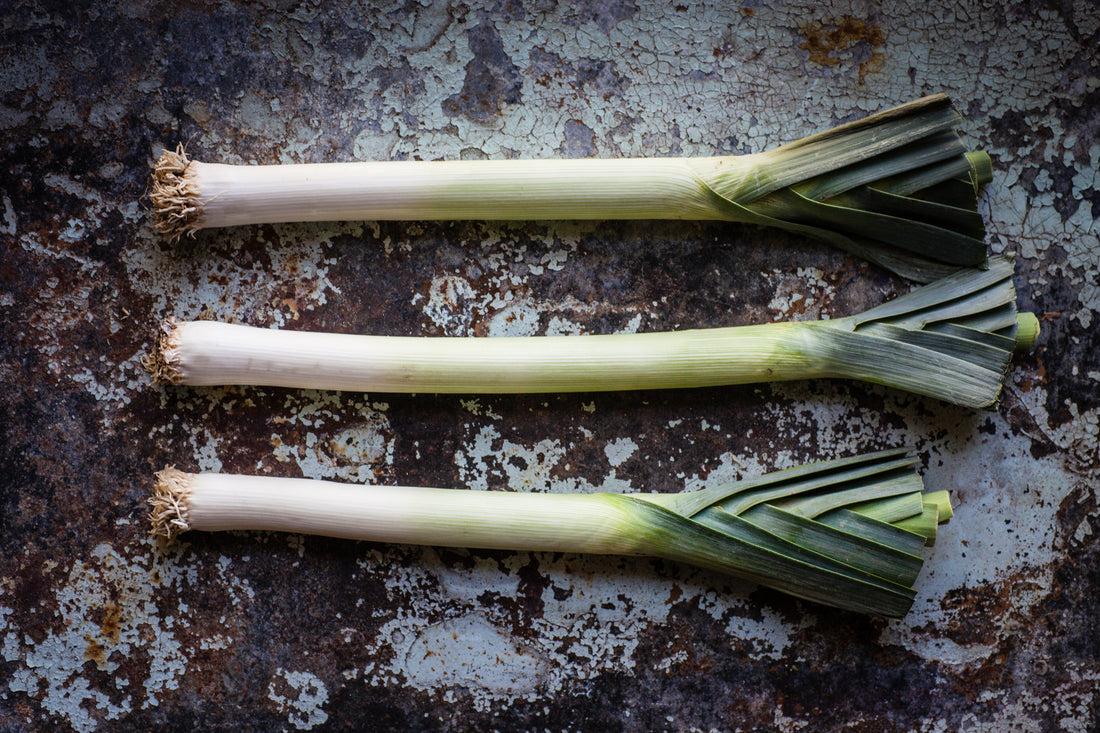The most essential quality necessary for growing leeks is patience. Leeks are slow growing, taking 4-7 months to develop into full size, mild, onion flavored bulbs, but worth the wait. They typically grow 2-3 feet tall, with an edible, mild-flavored stem that resembles a long, fat green onion. Once fully developed, leeks look similar to large scallions with blue-green foliage and white stalks. Leeks are delicious raw, in salads or in soups.
SOIL PREPARATION
Leeks prefer a loose, sandy soil, that is rich in organic matter, well drained, and not too heavy. They also need full sun exposure. Before planting, incorporate 2-3 inches of well composted organic matter and 1-2 lbs of all-purpose fertilizer (we recommend “That’s All it Takes” complete fertilizer) per 100 square feet and work them into the soil to a depth of 4-6 inches. Heavy, clay-based soils must be amended with compost and organic matter to encourage and allow good root development. If you have clay soil, we recommend 4-6 inches of organic matter and 50 lbs of Utelite or Zeolite per 200 square feet added to the soil each fall for multiple years to increase drainage and nutrient availability. Over time, you can create a better growing environment for your garden plants to thrive in and produce. Please see our information sheet “Preparing your Soil” for more detailed info on soil preparation before planting a garden
PLANTING
Leeks can be planted from seed or transplant. If possible, start seeds indoors to save time and to harvest earlier. Start indoors 6-8 weeks before planting season (early to mid-February). Seeds should be planted ¼ inch deep in a light, seed-starting mix, in whatever container is most convenient for you. When they are 6-8 inches tall, move the transplants outdoors (late march or early April). When planting, dig a 3-4 inch deep trench and space the seedlings every 3-4 inches, then cover them up with 2 inches of soil. Water them into place with Kangaroots root stimulator. Continue to use Kangaroots every 4-5 days for the first 3 waterings to prevent transplant shock and to speed up development. Bank up soil around the plants as they grow taller throughout the season to promote stronger stalks and to blanch the stems white. It is not unusual to mound the dirt up 6-8 inches around the stems during their growing season.
VARIETIES
Anderson’s offers one variety of leek from seed, American Flag, and one variety from plant, Lancelot. Both are excellent quality and develop in 130-150 days. Seedlings arrive at our greenhouse in late March and are typically available until the first week of May.
WATER
Water leeks deeply and frequently while trying to maintain even soil moisture, especially since they have a fairly shallow root system. Leeks need consistent watering for high quality production. Use a soaker hose for uniform water distribution and water lightly every 5-7 days to maintain soil moisture during these essential growth stages. A light compost mulch can help as well if daytime temperatures start to climb over 80 degrees.
FERTILIZER
Apply ½ cup per 10 feet of row of “That’s All it Takes” complete fertilizer or Happy Frog Organic Tomato & Vegetable Food 4 weeks after transplanting or thinning to encourage vigorous plant growth. Place the fertilizer evenly just to the side of the plants in the row and work it lightly into the soil before watering. Make sure to water it in! We also recommend treating your leek seed or plants with beneficial microbes and mycorrhizae (Kangaroots or Myke). These added helpers bring nutrients and water directly to the plants that host them, making them stronger, more resistant to insects and diseases, and more drought tolerant.
COMMON PROBLEMS
Keep the weeds to a minimum with diligence and persistence. Treflan and Corn Gluten weed preventative herbicides are also very effective ways to stop weeds before they start, saving you hours and hours of weeding, and they are completely safe to use on leeks. Be sure to control weeds when they are small to ensure damage is not done to tender, small root systems when weeds are removed. Practice crop rotations to discourage pest problems. Leeks have fewer problems than onions, but are still susceptible to thrips, onion maggots, and wireworms. Hi-Yield Multi-Use dust or Ferti-lome Broad Spectrum Insecticide work well for all the common insect problems.
HARVESTING
Leeks can be harvested when the stalks are 1-2 inches in diameter. A spading fork or trowel works best to loosen them from the soil. In milder climates, leeks can be wintered over if buried in the soil, but winter temperatures can damage them here in Cache Valley. Harvest and store leeks in a cool (35-40 degrees) and humid location.

